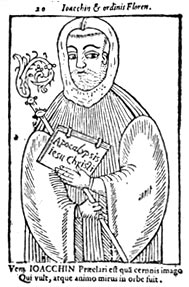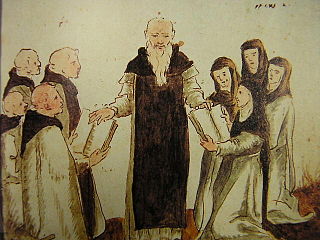
The Breviary of Alaric is a collection of Roman law, compiled by Roman jurists and issued by referendary Anianus on the order of Alaric II, King of the Visigoths, with the approval of his bishops and nobles. It was promulgated on 2 February 506, the 22nd year of his reign. It applied, not to the Visigothic nobles who lived under their own law, which had been formulated by Euric, but to the Hispano-Roman and Gallo-Roman population, living under Visigoth rule south of the Loire and, in Book 16, to the members of the Trinitarian Catholic Church; the Visigoths were Arian and maintained their own clergy.

The Codex Argenteus is a 6th-century illuminated manuscript, originally containing part of the 4th-century translation of the Christian Bible into the Gothic language. Traditionally ascribed to the Arian bishop Wulfila, it is now established that the Gothic translation was performed by several scholars, possibly under Wulfila's supervision. Of the original 336 folios, 188—including the Speyer fragment discovered in 1970—have been preserved, containing the translation of the greater part of the four canonical gospels. A part of it is on permanent display at the Carolina Rediviva building in Uppsala, Sweden, under the name "Silverbibeln".

Gaius Julius Phaedrus, or Phaeder was a 1st-century AD Roman fabulist and the first versifier of a collection of Aesop's fables into Latin. Nothing is recorded of his life except for what can be inferred from his poems, and there was little mention of his work during late antiquity. It was not until the discovery of a few imperfect manuscripts during and following the Renaissance that his importance emerged, both as an author and in the transmission of the fables.

Joachim of Fiore, also known as Joachim of Flora and in Italian Gioacchino da Fiore, was an Italian Christian theologian, Catholic abbot, and the founder of the monastic order of San Giovanni in Fiore. According to theologian Bernard McGinn, "Joachim of Fiore is the most important apocalyptic thinker of the whole medieval period." The Divine Comedy of Dante Alighieri is one of the most famous works possibly inspired by his ideas.

A scroll, also known as a roll, is a roll of papyrus, parchment, or paper containing writing.
The Berlin Codex, given the accession number Papyrus Berolinensis 8502, is a Coptic manuscript from the 5th century AD, unearthed in Akhmim, Egypt. In Cairo, in January 1896, Carl Reinhardt bought the codex, which had been recently discovered, wrapped in feathers, in a niche in a wall at a Christian burial site. It was a papyrus bound book, dating to early 5th century that was written in Sahidic dialect of Coptic, which was in common use in Egypt during that time.

The Joachimites, also known as Joachites, a millenarian group, arose from the Franciscans in the thirteenth century. They based their ideas on the prior works of Joachim of Fiore, though rejecting the Church of their day more strongly than he had. Joachimite beliefs were condemned by the Fourth Council of the Lateran and Joachimite interpretations became popular during the Protestant Reformation, and even influenced some Protestant interpretations. He also divided history into three ages: the ages of the Father, the Son, and the Holy Spirit.
Gherardello da Firenze was an Italian composer of the Trecento. He was one of the first composers of the period sometimes known as the Italian ars nova.

The Vaticinia Michaelis Nostradami de Futuri Christi Vicarii ad Cesarem Filium D. I. A. Interprete, or Vaticinia Nostradami for short, is a collection of eighty watercolor images compiled as an illustrated codex. A version of the well-known Vaticinia de Summis Pontificibus of the 13th–14th century, it was discovered in 1994 by the Italian journalists Enza Massa and Roberto Pinotti in the Biblioteca Nazionale Centrale di Roma in Rome, Italy. The document can be found in the library under the title Fondo Vittorio Emanuele 307.

San Giovanni in Fiore is a town and comune in the province of Cosenza in the Calabria region of southern Italy.
Abraham von Franckenberg was a German mystic, author, poet and hymn-writer.

A series of manuscript prophecies concerning the Papacy, under the title of Vaticinia de Summis Pontificibus, a Latin text which assembles portraits of popes and prophecies related to them, circulated from the late thirteenth-early fourteenth century, with prophecies concerning popes from Pope Nicholas III onwards.
Egidius de Francia was a French music theorist of medieval music, known for the short treatise De motettis componendis. He possibly was an Augustinian friar, as in a miniature illumination he is titled Magister Egidius Augustinus. Along with "Guilelmus de Francia", he was probably a friar at the Monastery of Santo Spirito in Florence.
Telesphorus of Cosenza was a name assumed by one of the pseudo-prophets during the time of the Western Schism. As an pseudonymous author of a Latin work Liber de magnis tribulationibus, the name was attached to a 1365 production of the Fraticelli. The Liber was updated to fit the situation in the Schism.
William Reeves was an Irish antiquarian and the Church of Ireland Bishop of Down, Connor and Dromore from 1886 until his death. He was the last private keeper of the Book of Armagh and at the time of his death was President of the Royal Irish Academy.
Ludolf Küster (1670–1716) was a Westphalian scholar, philologist, textual critic, palaeographer, and editor of Greek ancient texts.

Professor Eldred Durosimi Jones was a Sierra Leonean academic and literary critic, known for his book Othello's Countrymen: A Study of Africa in the Elizabethan and Jacobean Drama. He was a principal of Fourah Bay College. Jones died in Freetown, Sierra Leone, around 1am on Saturday, 21 March 2020.
Jacopo Brocardo was an Italian Protestant convert and biblical interpreter. He regarded the year 1584 as the inauguration of a major new cycle. He prophesied that the last age would last 120 years from the birth of Martin Luther in 1483. As an apocalyptic thinker he was influenced by Martin Cellarius.
Marjorie Ethel Reeves, was a British historian and educationalist. She served on several national committees and was a major contributor to the education of history in Britain. She helped create St Anne's College as part of Oxford University in 1952, and she led a revival of interest in the work of Joachim of Fiore.
Warwick Leslie Gould, is a literary scholar born in Sydney. He specializes in the Irish Literary Revival, particularly in the writings of W. B. Yeats, and in Textual Transmission studies and the History of the Book. Having studied at the University of Queensland, he joined Royal Holloway and Bedford New College in 1973 as a Lecturer in English Language and Literature. He became Professor of English Literature of the University of London (1994–2013) and was the Founding Director of the Institute of English Studies in the university's School of Advanced Study (1999–2013). He continues as Professor Emeritus since his retirement in 2013 and is a Senior Research Fellow of the institute.









